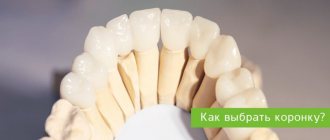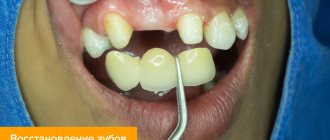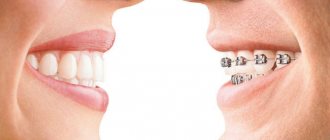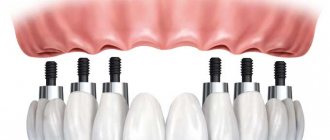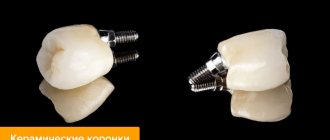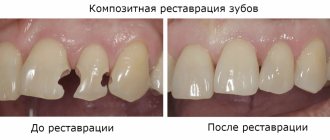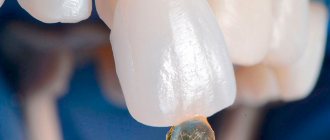A dental crown helps restore a badly damaged tooth in the most hopeless situation. Return it to its previous form and function, and subsequently protect it from caries. Modern dentistry offers not only reliable, but also aesthetic orthopedic structures that meet the highest requirements of patients. Mikhail Gennadievich Kuryatnikov, an implantologist and orthopedist and chief physician at the Andent clinic in Moscow, talks about what dental crowns are, what they are like and what their price is.
When is it necessary to put a crown on a tooth: indications for restoring teeth with a crown
The need to place a crown on a tooth may arise in the following situations:
- The tooth is severely damaged by caries. If the natural crown of a tooth is damaged by more than 50% by caries, then it would be more correct to put a crown on the tooth rather than restore it with a filling. Large fillings do not withstand the chewing load well and may fall out or break, and the tooth may break along with the filling. If the root of the tooth is damaged, then it will have to be removed. By placing a crown on a decayed tooth, you have the opportunity to save it;
- The tooth is destroyed as a result of trauma. If the roots of a tooth were not affected by injury, it is possible to restore the tooth - it will be enough to put a crown on it;
- You can also put a crown on a tooth for aesthetic restoration: for example, if a tooth is chipped or its enamel has changed color, becoming gray or yellow, and this defect cannot be eliminated by classic whitening.
Doctors recommend placing temporary crowns to preserve teeth for patients with periodontitis. In this case, crowns prevent teeth from becoming loose and falling out.
In your case, do you need to put a crown on your tooth or is it possible to use another restoration method? The doctors of our dental clinic in Moscow, “Firadent,” can help you find the answer to this question. To make an appointment with our specialists, you just need to dial our dental clinic’s phone number!
Which crown is better - metal-ceramic or zirconium?
A bit of an incorrect question.
In terms of strength and aesthetic characteristics, these crowns are very close to each other.
On front teeth, zirconium crowns are more preferable due to their increased transparency.
But in the area of chewing teeth, we would not recommend using zirconium crowns due to the lower strength of the frame.
Therefore, the ideal option would be to use metal-ceramics in the area of the chewing teeth, and zirconium crowns in the area of the front teeth.
I need to put a crown on a tooth: is the treatment painful?
Statistics show that most people, knowing that they need to put a crown on a tooth, still postpone their treatment for fear of visiting the dentist and the pain that supposedly cannot be avoided with dental prosthetics. Does it really hurt to put a crown on a tooth? Let's look at this issue together.
So is it painful to put a crown on a tooth or not? The most painful stage in the process of installing a crown on a tooth will be the preparation, during which the teeth are treated for caries, depulped (if necessary), and also ground down to the thickness of the future crown. All these procedures are not performed without anesthesia, as they can cause quite severe pain to the person.
Before you begin to treat and prepare the tooth for placing a crown on it, the doctor will definitely perform an anesthesia procedure using a local anesthetic. The type and amount of the drug are selected individually for each patient. The use of anesthesia makes the process of preparing the tooth for crown installation painless.
If the patient experiences a literally panicky fear of dentists, in our dental clinic “Firadent” he may be offered dental treatment in his sleep[/anchor], under sedation. Sedation should not be confused with general anesthesia; it is a light medicated sleep in which the patient will remain during treatment. Sedation allows you to relieve the patient not only from pain when preparing teeth for prosthetics, but also from psychological discomfort and stress! Moreover, after sedation there are no negative side effects, which are not uncommon after general anesthesia.
You can read all the details on dental treatment during sleep in a separate article on our website, which is devoted to sedation, or find out during a consultation with the doctors of our clinic - “Firadent”.
Free consultation on the cost of treatment in our dentistry
Leave a request and the clinic administrator will contact you within 15 minutes!
For single-rooted dental units, the depulpation process is mandatory, since the risks of thermal burns during grinding are quite high and this is fraught with the future development of an inflammatory process under the crown. Single-rooted teeth are drilled out, the nerve is removed, and the canals are cleaned and filled.
If there are dental diseases - caries, pulpitis, periodontitis - manipulations are performed to treat them. The nerves of the unit are removed, the canals are expanded with a special instrument, filled with gutta-percha, after which a filling is installed on the tooth itself. In case of serious damage to a tooth due to caries, it is important to install a strong filling and provide additional fixation. If this is not done, the dental crown may simply fall out along with a poor-quality filling. The process of restoration of a natural dental crown can be implemented in practice using two methods:
1. Installing a crown on a pin. The pin element is screwed into a pre-filled root canal and the natural coronal part of the tooth is restored at its base. After the filling is made, it is ground down to install the crown.
2. Using a stump insert. This element is manufactured in laboratory conditions and, when installed, is fixed in two areas at once: the dental canal and the area of the natural tooth crown.
These labor-intensive manipulations are carried out exclusively in the presence of serious destruction in the area of the natural dental crown, and if we compare the methods in terms of reliability, then the most high-quality result can be obtained by placing a stump inlay.
Initial examination and diagnosis
The decision that a crown needs to be placed on a tooth is made by an orthopedic dentist after examining the patient’s oral cavity and teeth, as well as performing a number of diagnostic measures. Based on the data obtained, the orthopedist will develop a treatment plan, which may include not only the installation procedure itself, but also a number of additional measures:
- Professional oral hygiene, which allows you to clean your teeth from plaque and tartar;
- Removal of severely damaged teeth that cannot be properly treated and restored with a filling;
- Treatment of caries and any other diseases of the teeth and gums diagnosed during examination;
- Tooth removal, treatment and filling of canals.
Note that depulping a tooth before placing a crown on it is not always done. The depulpation procedure involves removing the dental nerve, after which the tooth becomes more fragile and vulnerable to external factors. If a tooth has more than one root and is in good condition, doctors prefer not to remove the dental nerve and put a crown on a living tooth.
When drawing up a treatment plan, the question of what kind of crown will be placed on the tooth is also decided. Modern dental crowns are made from different materials and there is always the opportunity to choose the version of the prosthesis that will most suit the patient in terms of aesthetics, price and durability.
The drawn up treatment plan is agreed with the patient and after agreement the treatment process begins. The first step is to prepare the tooth for the installation of a crown.
Indications and contraindications
Before installing a cast dental prosthesis, it is necessary to take into account all available indications and contraindications. Cast crowns are installed in the following cases:
- destruction of most of the tooth, when installation of a filling becomes impossible;
- to strengthen the lateral teeth and restore chewing function;
- when a pathological weakening of tooth enamel is detected in a patient;
- in case of mechanical injury leading to a chip or crack;
- to correct malocclusion;
- when diagnosing bruxism in a patient.
The main contraindication is the patient’s allergic reactions to any type of metal or metal alloy. In this case, you will have to resort to installing a denture structure made of hypoallergenic material.
A cast metal crown is not suitable for people suffering from hypersensitive teeth, since any type of metal has good thermal conductivity. Constant thermal exposure can lead to inflammation of the pulp. The teeth located on the opposite jaw will be regularly subjected to wear when in contact with metal, which will significantly worsen their condition.
Preparing to install a dental crown
Preparing for a dental crown may include the following procedures:
- Professional teeth cleaning. Removing tartar and plaque from the surfaces of teeth will help you accurately select the color of the future crown, as well as identify primary caries and other diseases that are important to cure before placing a crown on the tooth.
- Treatment of caries, pulpitis, periodontitis, and gum inflammation. You can’t put a crown on sick teeth!
- Treatment of the tooth on which a crown will be placed. During this process, the doctor will drill out the tooth and remove all tissue affected by caries. If necessary, tooth depulpation is carried out, as well as treatment and filling of dental canals.
IMPORTANT: Dental canal treatment must be of high quality! If during the treatment of the canals the doctor makes a mistake, does not remove all the tissues affected by inflammation, or fills the canals incorrectly, the tooth may begin to hurt already under the crown, and then it will have to be removed and treated again! In our dental clinic “Firadent” in Moscow, treatment of tooth canals is carried out under a microscope with an optical device, which allows the doctor not to act at random, but to accurately see the length and internal space of the dental canals, and therefore carry out the procedure with impeccable quality.
After filling the canals, the tooth is restored with a filling and the next stage in prosthetics begins - turning the tooth under a crown.
Restoration with crowns is indicated in the following cases:
- aesthetic defects (chips, stains, cracks, diastemas, trema, curvature, etc.);
- single or complete destruction of teeth with preservation of the root;
- uneven gum line;
- bite pathology;
- pathological abrasion and discoloration of enamel;
- restoration of lost functions (biting, sharing food, diction).
The front incisors are not associated with the chewing function, so there are no strict requirements for the strength of the crowns. The doctor’s task is to recreate the anatomical shape and color of natural teeth, maintain their degree of transparency, and achieve a perfect match of sizes.
Grinding a tooth for a crown
Before placing a crown on a tooth, the tooth must be ground to the thickness of the future prosthesis. This procedure in professional dentistry is called “preparation”. The enamel of the tooth is ground down with a drill and during the treatment the doctor will give the tooth a shape that will allow the crown to be placed firmly and tightly.
IMPORTANT: Grinding of live teeth can be quite painful, so local anesthesia must be administered before performing this procedure. If the tooth was depulped before grinding, local anesthesia may not be used, the procedure will not cause pain.
When preparing teeth, a layer of tissue is removed from the tooth before placing a crown. The thickness of the layer will depend on how thick the crown will be. A minimal layer of tissue is removed from the teeth for cast crowns; a significant layer of tissue must be removed from the tooth if it is decided to install ceramic or metal-ceramic crowns. On average, during the grinding process, about 2.5 mm of tissue is removed from a tooth on each side.
As a result of tooth preparation, a core base (stump) is obtained, on which the doctor will place a crown.
What problems can arise with crowns?
In order to ensure that the installed crown does not have to be removed due to negative consequences, it is necessary to minimize the risk of their occurrence. To do this, you need to carry out prosthetics in a serious clinic with qualified personnel. However, sometimes various complications still arise, the most common of which are stomatitis, gingivitis, caries and allergic reactions.
The cause of stomatitis and gingivitis, as a rule, is strong pressure on the gum due to the missing gap between it and the crown. The development of caries is usually caused by a loose fitting denture. Allergic reactions occur due to the individual reaction of the body to the material from which the artificial tooth is made.
Important! After dentures, there should be no toothache. If the pain does not subside within several days, but rather intensifies, an urgent panoramic photograph of the jaw should be taken. This will make it possible to identify the cause of pain and determine ways to eliminate it.
In some cases, they resort to removing the installed prosthesis. This is required when:
- poor-quality filling of dental canals;
- the presence of dental instruments in the canals;
- large gap between the product and the tooth itself;
- significant damage to the product.
It should also be taken into account that almost any denture has a limited service life, after which it must be removed and replaced with a new one.
Making crowns
Crowns are made from an impression that is taken from the prepared teeth. To obtain this impression, the orthodontist will use a special plastic mass. Based on the impression taken, the laboratory will first make a plaster model of the prosthesis, and then a crown, which will be placed on the tooth.
Modern dental crowns are made from different materials: metal, ceramic, metal-ceramic and zirconium. The timing of the production of the prosthesis will depend on what kind of crown it is decided to place on the tooth. Crowns made of ceramics and metal-ceramics take the longest to produce. So that a person does not have to walk without a tooth during the entire time of making the crowns, a temporary plastic prosthesis is put on the tooth.
IMPORTANT: Temporary plastic crowns help hide a defect in the dentition; a person will not have to be embarrassed by the absence of a tooth and experience stress for this reason. Also, temporary dentures help protect a ground and therefore weakened tooth from the negative effects of environmental factors and bacteria.
When is it recommended to get a crown?
These prostheses need to be installed in the following cases:
- when most of the tooth is affected by caries;
- severe destruction of the dental organ (more than 70%);
- the tooth is destroyed after injury, the root must be intact;
- external defects of teeth (hereditary or acquired), changes in their color when aesthetics suffer;
- enamel predisposition to pathological abrasion;
- loosening of teeth, which is the cause of periodontal disease (temporary dentures will make them more stable);
- when a bridge is installed, thanks to the crowns it is fixed to the supporting teeth;
- the presence of uneven edges on the tooth, which injure the mucous membrane.
Try-on, temporary and permanent fixation of the crown
Before placing a crown on a tooth, it must be tried on. For this purpose, the patient is invited to the clinic. During the fitting, the accuracy of the crown's manufacturing and the tightness of its fit on the stump base are assessed. If the fitting does not reveal manufacturing inaccuracies, the patient does not feel discomfort and is satisfied with the aesthetics of the finished product - a temporary fixation of the crown is performed on the tooth.
What is temporary fixation? This is a kind of “test drive” of the crown. With a crown placed on a temporary basis, the patient will walk for a certain period of time (usually up to 4 weeks). If during this time no defects or inaccuracies are identified in the manufacture of the crowns, the patient comes to the clinic and the crown is placed and fixed with permanent dental cement.
At this point, the crown installation process can be considered complete.
What are the complications?
Let's consider complications that can appear after the installation of crowns:
- Strong pressure from the product on soft tissue disrupts blood circulation and contributes to the formation of bedsores. In this case, the soft mucous membrane can die off at the point of contact between the gums and the crown. This is how prosthetic stomatitis can develop.
- Damage to supporting dental units by caries. Poor cleaning of the oral cavity or poor preparation of the dental organs for the installation of a prosthesis leads to the accumulation of food particles under the crown, where bacteria that cause disease develop.
- An allergy to the metals that make up the prosthesis may not appear immediately after installation of the structure, but after some time. There is a burning sensation in the mouth, dryness, and inflammation occurs.
- Galvanic syndrome can be caused by the presence of various metals in the mouth. The result is the formation of an electric current, which enhances oxidative reactions. At the same time, the patient feels a metallic taste in the mouth, there may be a general malaise, a headache, the structure and neighboring dental organs may change color.
Each of these complications requires a quick reaction and a visit to the attending physician, otherwise you may lose the supporting tooth. The doctor will most likely remove the crown, perform treatment and install a new one.
How to place a crown on an implant?
A crown can be placed not only on a tooth, but also on an implant. This allows you to restore lost teeth without grinding down healthy units in the rows. Crowns on implants are durable, aesthetic, and visually indistinguishable from natural teeth.
Before placing a crown on an implant, an artificial root implantation procedure is performed. As soon as the implant takes root, an abutment is placed on it, and then a crown. Putting a crown on an implant will be more expensive than conventional prosthetics, but the price of the service is fully compensated by the impeccable aesthetics and long service life of both the implant and the crown.
Reviews
Elena, 29 years old
After building up two front incisors, one of them fell off completely, and only half remained on the other. Now I’m wondering whether to put crowns on them, or is it better to have them built up again by another specialist?
Egor, 45 years old
I was very worried after attaching the crowns with permanent cement. I had already put crowns on myself twice before and the doctor always pressed hard on the prosthesis when putting it on, and the last time he just held it. I panicked that it would quickly disappear. I asked another specialist - he explained that after putting the prosthesis on the cement, I treat it with a special lamp, which leads to hardening, so strong pressure is not required. I've been wearing crowns for over a month now. Everything suits me.
Anton, 32 years old
Placed zirconium crowns on 3 front incisors. I spent a lot. But a week later one of them fell out. I went to the doctor, he said that there was temporary cement and installed it again. Then, one by one, with an interval of two days, the remaining two crowns fell out. Again I went to the doctor twice and twice he changed the temporary cement, which is not permanent. I can’t understand why he couldn’t immediately attach all three to me with permanent cement when I came in for the first time? And what’s also annoying is that after the crowns were re-installed, biting on these teeth became somehow not so much painful, but rather scary. And this fear still does not go away.
Polina, 31 years old
After installing the crown, I feel that it is bothering me and does not connect to the opposite tooth properly. And my gums still hurt a little. Although during the fitting everything was fine. What to do in such a situation? Will I have to remove the prosthesis?
Crown service life
Patients who plan to get a crown are often interested in its useful lifespan. The service life of a crown placed on a tooth will depend on a number of factors:
- Crown material and technology;
- The patient’s compliance with all doctor’s recommendations for crown care;
- Quality of preparation of teeth for prosthetics.
The last factor is of fundamental importance: if mistakes are made during the preparation and manufacturing of the crown, the crown will not last long, and undesirable complications may arise, due to which the crown will have to be removed and re-installed on the tooth. For these reasons, you need to very carefully choose the clinic where you plan to treat and restore your teeth! Remember that the worst type of saving is saving on your own health!
The crown must be placed in a well-equipped dental clinic, staffed by experienced orthopedic doctors and dental technicians. The clinic must use the most modern technologies for diagnostics, treatment and dental prosthetics; only this approach to the choice of dentistry guarantees high quality treatment!
Removal methods
Removing the product is quite difficult, especially if you need to keep it intact in order to reinstall it.
If removal is due to a broken structure, it is better to cut it with special tools.
If it is necessary to preserve the prosthesis, the following is used to remove it:
- Crown removers (the most common are Kopp hooks) are special tools in the form of flat hooks that can be automatic or manual. With their help, the prosthesis is removed at the part where it connects to the tooth.
- The forceps securely grasp the prosthesis with its jaws and remove it from the base.
- Ultrasonic installations. Ultrasound waves can destroy the adhesive cement, after which the prosthesis can be easily removed.
- Pneumatic tools, the use of which also contributes to the destruction of cement and facilitates the removal of the crown.
How much does it cost to put a crown on a tooth?
How much does it cost to put a crown on a tooth? It is difficult to give a definite and precise answer to this question, because the cost of installing a crown may include various additional but necessary procedures. For example, professional teeth cleaning, treatment of caries or pulpitis, treatment and filling of canals.
The cost of installing a crown will be influenced by both the material and the production technology of the prosthesis. The most expensive options are ceramic and zirconium crowns produced using CAD/CAM technology. But such crowns fully pay for their cost due to their high strength, reliability and aesthetics.
Also, the cost of installing a crown will depend on how it will be placed - on an abutment tooth or on an implant.
The best way to find out how much it costs to put a crown on a tooth is to come to an appointment with orthopedic doctors at our dental clinic in Moscow - “Firadent”. Experienced specialists of our dentistry will conduct an examination and diagnosis and draw up a treatment plan, which will indicate the exact price of the service.
Metal crowns have obvious advantages.
- They are quite easy to install. Fixing crowns made of metals or their alloys does not require extensive grinding of the teeth.
- The structures are characterized by high strength.
- The crowns are comfortable and easy to use.
- The structures hide dental defects well.
- When metal crowns are installed, the functionality of the teeth is fully restored.
- Metal structures have a long service life. They have high wear resistance, so such crowns very rarely break.
Which dentistry in Zvenigorod is best to choose for prosthetic crowns?
There are many dental clinics in Zvenigorod.
One of them is the dental department of the Istok Health Clinic. The dental clinic has been operating in Zvenigorod since 1992. There are 7 dental offices equipped with the most modern equipment, its own dental laboratory, X-ray room, and sterilization department. Here you can receive a full range of dental services, and you can get an appointment at virtually any convenient time. The Clinic's management closely monitors the quality of services provided and materials used.
How does the manufacturing process work?
The first stage of the metal-ceramic crown manufacturing process is taking impressions from a two-layer impression mass. In most cases, for high-precision reproduction of all details on an impression, textile threads are used, which are put on the tooth and push back the gum.
Based on the casts obtained, a plaster model is cast. Next, the dental technician makes a wax model of the frame and sends it to the dental laboratory. The duplicate is processed and then becomes suitable for patient fitting.
At this stage, the desired shade and transparency of the crown is determined. If the duplicate is the perfect size, it is sent to the laboratory for application of an enamel layer and polishing. Finally, a final firing with glaze is carried out.
Stages and timing of prosthetics
Modern dental prosthetics is an affordable and diverse technology for restoring lost teeth. And all because the first attempts to replace lost teeth appeared more than a hundred years ago. Naturally, at that time they were not particularly successful, but today’s prostheses change their appearance every year, becoming more and more comfortable and natural.
How is the prosthesis installed?
To fix dentures, some kind of support is required: this can be the root of a living tooth, for example, reinforced with an inlay or a metal pin, or pre-installed dental implants (these are artificial analogs of roots made of metal). In addition, gums can also serve as a support for dentures (but only removable ones) - if there is a need to restore completely lost teeth in a row.
Installation of dentures is carried out in several stages:
- selection of the type of prosthesis: you need to choose a design that suits you not only in price, but also in comfort - it is better to overpay a little, but get a comfortable prosthesis,
- preparation for dental prosthetics: before installing dentures, it is imperative that the teeth are cured and anti-inflammatory therapy of the gums is carried out (if necessary). If dentures are fixed on living teeth, then they are given the desired shape - exactly repeating the internal cavity of artificial crowns,
- Impression taking: Wax impressions are made and used to develop a model of the patient's entire jaw. Subsequently, it will be used to make a prosthesis, which is created taking into account the location of all teeth in the jaw,
- prosthesis manufacturing: carried out in a dental laboratory by a technician,
- fitting and fixation of the prosthesis: if the prosthesis fits perfectly and does not cause discomfort, the doctor fixes it in the oral cavity. If necessary, the design is adjusted.
After the denture is installed, the doctor must give advice to the patient - what to do with the new artificial teeth, how to carefully remove them from the mouth (if the denture is removable), how to properly care for it and what foods to eat so as not to damage the crowns.
On average, dental prosthetics with permanent structures takes from 5-7 days to 3-4 weeks.
The production time for each prosthesis is strictly individual and depends on the size of the prosthesis, its shape, the type of material used, as well as the presence or absence of metal fasteners.
However, the patient should not despair, because while the permanent structures are being manufactured, he will be offered temporary template prostheses, the installation of which will take only a few hours.
Dental crowns
| Metal-ceramic dental crowns | 5-10 days |
| Metal dental crowns | 4-7 days |
| Ceramic dental crowns | 4-7 days |
| Metal-plastic dental crowns | 5-10 days |
| Crowns based on zirconium dioxide or aluminum | 7-10 days |
In many ways, the production time for dental crowns depends on the method of their fixation, for example, on a natural tooth, a pin and an implant.
Dental bridges
The production time for dental bridges varies depending on the number and type of crowns that are used as part of the bridge. In general, work on a dental bridge by a dental technician takes 10 days or more.
Manufacturing time for removable dentures
| Clasp dentures with hooks | 10-12 days |
| Clasp dentures with attachments | 3-4 weeks (from 20 days) |
| Clasp dental crowns on telescopic crowns | 3-4 weeks (from 20 days) |
| Nylon dentures | 7-10 days |
| Soft plastic dentures | 5-10 days |
| Plate dentures | 13-16 days |
The table shows only the average time for dental technicians to complete work. Depending on the workload, the patient may be asked to complete the work much faster than the stated deadline. However, many dental laboratories operate using the “urgent order” system. The production time for a prosthesis can be halved, but at the same time you will have to pay at least twice as much for urgency.
When making a prosthesis, the dental technician will also have to carry out a mandatory fitting of the product, and for this the patient will need to arrive at the appointed time for an appointment with a specialist. Otherwise, the delivery time for the finished product will increase by several more days.
